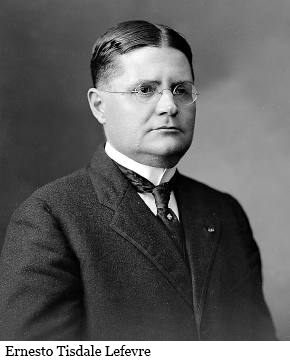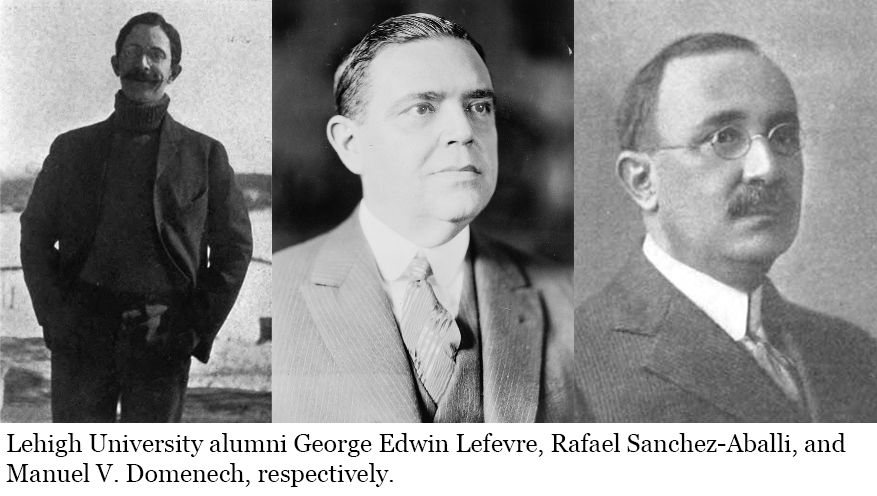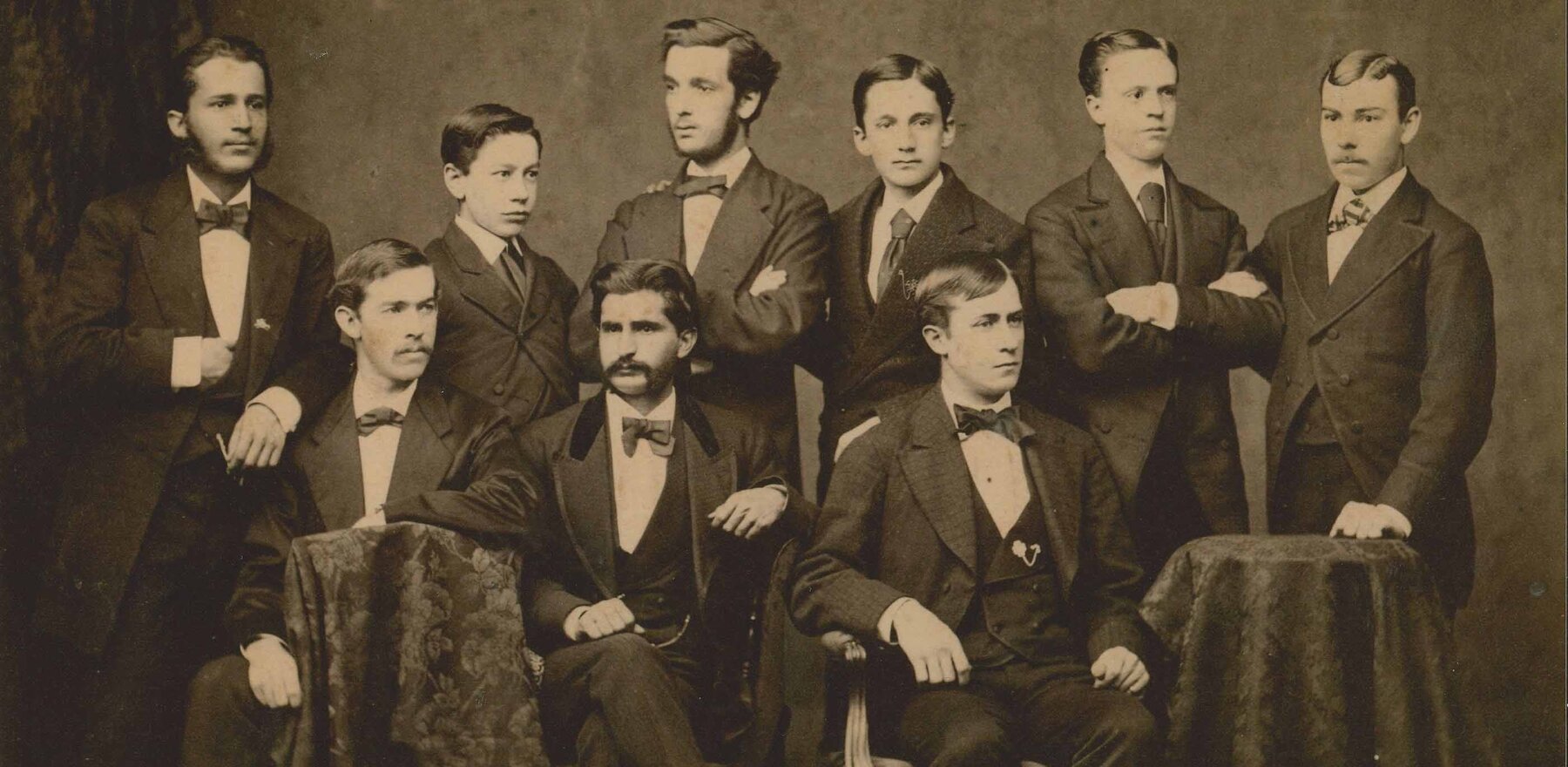International engagement with Latin American countries has been a central part of the Lehigh experience since the earliest days of the university’s history
Ernesto Tisdel Lefevre spent 10 months as President of Panama in 1920, following the resignation of his predecessor, Belisario Porras. During his brief but accomplished tenure, Lefevre resolved Canal Zone labor disputes, vetoed a controversial bill seeking raises for government officials, prevented the stationing of overseas troops on the island of Taboga, and created a school for pharmacy, surveying, and agriculture.
 Lefevre was an accomplished politician, as well as a highly successful businessman who amassed a great fortune through his investments in real estate, insurance, and farming.
Lefevre was an accomplished politician, as well as a highly successful businessman who amassed a great fortune through his investments in real estate, insurance, and farming.
He was also a Lehigh University graduate.
Born in Panama City in 1877, Lefevre received his primary education in his home country, but enrolled at Lehigh to earn his electrical engineering degree, returning to Panama after graduating in 1896.
His success story is one of many that illustrate how international engagement with Latin American countries has been a central part of the Lehigh experience since the earliest days of the university’s history. That engagement continued this month as Lehigh President Joseph J. Helble visited Ecuador, Colombia, Guatemala, and Panama during his first trip overseas as the university's president.
“It’s very appropriate that President Helble’s first international trip is to Latin America, because Lehigh has such a deep history of engagement with that part of the world,” said Cheryl Matherly, Vice President and Vice Provost for International Affairs at the Lehigh’s Office of International Affairs (OIA), who accompanied Helble on the trip.
Lehigh's First International Students
In fact, Lehigh’s very first international students came from Brazil, more than 150 years ago.
 Hildebrando Barjona de Miranda and Raymundo Floresta de Miranda came to Lehigh in 1868 – just three years after the university was founded – to study mechanical engineering and analytical chemistry. Many of Lehigh’s international students originally came to Lehigh because of its well-known programs in engineering and mining technologies, which were in high demand in their home countries.
Hildebrando Barjona de Miranda and Raymundo Floresta de Miranda came to Lehigh in 1868 – just three years after the university was founded – to study mechanical engineering and analytical chemistry. Many of Lehigh’s international students originally came to Lehigh because of its well-known programs in engineering and mining technologies, which were in high demand in their home countries.
The names Hildebrando and Rauymundo are proudly displayed on a plaque on the walls of Coxe Hall at Lehigh’s campus today. Next to it is a photo of Brazilian students J.C. da Gama Malchar, Franciso Jordaõ, and J.J. de Gama Malcher, sitting for a portrait with their Sigma Beta Xi fraternity brothers in 1874.
Just as international students have been part of Lehigh since its earliest years, students from overseas have been welcomed into student clubs and academic organizations.
This is reflected in past editions of the alumni magazine, Bulletin, that recall such groups as Club Hispano Americano in 1891, Sociedad Hispano Americano in 1898, Circulo Ibero Americano de la Universidad de Lehigh in 1907, and Centro Latino Americano Lehigh Club in 1915.
Today, OIA provides myriad programs and initiatives for Lehigh’s international students. The Office of International Students and Scholars provides holistic support and advising, the International Center for Academic and Professional English improves their communication skills, and the Iacocca Institute provides immersive learning experiences in entrepreneurship, leadership, and more. More than 50 students from Latin American countries are currently enrolled at Lehigh, and overall international student enrollment has nearly returned to pre-pandemic levels. Lehigh has several global partnerships and faculty research projects ongoing with Latin American institutions (see pages 10-11), and many clubs for Latin American students are active on the campus, such as the Society of Latino Professionals For America, the Brazilian Student Association, the Latin Dance Club, and several Latin American sororities.
“Lehigh University is committed to preparing our students to engage with the world and lead lives of meaning,” Matherly said. “Lehigh is a truly international campus, and global engagement is crucial for our graduates to effectively handle complex challenges and thrive professionally and personally in today’s international arena.”
Prestigious Latin American Alumni
 Lefevre had two other brothers who also attended Lehigh University. George Edwin Lefevre, 1891, became a renowned journalist and novelist best known for his writings about Wall Street, while Henry Francis Lefevre, 1892, became a prominent consulting mining engineer.
Lefevre had two other brothers who also attended Lehigh University. George Edwin Lefevre, 1891, became a renowned journalist and novelist best known for his writings about Wall Street, while Henry Francis Lefevre, 1892, became a prominent consulting mining engineer.
But the Lefevre brothers are just a few Lehigh alumni to enter prestigious positions in Latin American countries after graduation.
Another Lehigh alum, Rafael Sanchez-Aballi, became the Cuban ambassador to the United States in 1925. A wealthy sugar planter from Cuba’s Oriente Province, Sanchez-Aballi was an 1898 graduate of Lehigh, where he was affectionately known as “Fatty,” according to a letter he wrote that was published in the Bulletin in 1925.
“A great honor and distinction to me,” he wrote of his ambassadorship, “and as a good son, wish my Alma Mater to rejoice in my success, as to her is due a great part of it. Will be in New York after the 18th at the Plaza Hotel where, with true Lehigh spirit, will welcome you all.”
Brazil, Guatemala, and Colombia remain among the top sending countries for Lehigh’s international students at Lehigh, and many of the university’s global partnerships and faculty research are based in Latin American countries. The engagement and collaboration between Lehigh and Latin America are as alive today as it was during the university’s earliest years.
Other Early Lehigh Alumni
- Miles Rock, an 1869 Lehigh graduate, worked extensively in Latin America, and led the Guatemala Commission to determine boundary between Guatemala and Mexico
- C.W. Haines, 1874, was an engineer who assisted with construction of Mexican National Railroad and theInter-Continental Railroad of Guatemala
- Richard Hawley Tucker, 1879, an astronomer and Director of Licks Observatory in California, traveled to Argentina to record important astronomical observations
- Don Eduardo Perez-Triana, 1887 became theNicaraguan minister to France, and later to Great Britain
- Manuel V. Domenech, 1888 became a member of Puerto Rico’s House of Representatives, and later the mayor of Ponce
- Aldolfo Cordenas, 1890, held various political positions in Nicaragua, including Minister of Finance & Public Credit
- Harvey Bassler, 1908, took extensive notes and wrote journals during his time as a geologist in Peru, later donated a large portion of his library to Lehigh
- Dr. Victor Levi Sasso, 1958, prominent Panamanian professor, civil engineer, and writer who founded the Technological University of Panama
(The photos above are in the public domain.)
